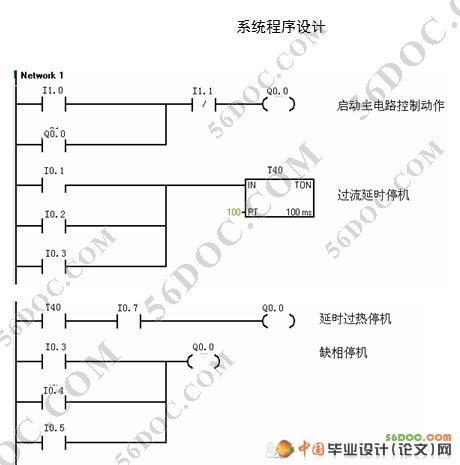基于PLC的电机故障诊断系统设计论文(西门子S7-200)
来源:wenku163.com 资料编号:WK1633874 资料等级:★★★★★ %E8%B5%84%E6%96%99%E7%BC%96%E5%8F%B7%EF%BC%9AWK1633874
资料介绍
摘要
本文介绍了国内电机故障诊断系统设计方法,以及存在问题,同时介绍了可编程控制器的工作原理,选型依据。设计了一种基于PLC电机故障诊断系统,详细介绍了所选用的西门子S7-200PLC系列,根据设计要求对PLC的输入输出I/O进行了分配,并且编写系统运行的梯形图。在设计中,首先是对这个系统做了整体介绍以及选题的意义,和用PLC诊断系统的优点。其次,对系统中涉及到的相关内容做了初步介绍,包括PLC的选型和相关参数,编程软件介绍以及在硬件电路中的相关元器件。具体选择电机的工作情况并对其常见的故障进行分析,分别对各个故障的检测做出相应的动作,和画出各部分的电路图。最后,对系统的整体设计进行总结。
关键词:电动机 ,故障诊断,PLC
Abstract
This paper introduces the domestic electrical fault diagnosissystem design, as well as existing problems, and introduced aprogrammable controller at the same time the working principle ofselection basis. A PLC-based design of the electrical faultdiagnosis system design, detail on the choice of Siemens S7-200 PLC, according to the designrequirements of the input and output of the PLC I / O fordistribution, and preparation of the ladder diagram systemoperation. In the design, the first is the introduction of this system as a whole as well as topics of significance, and diagnostic systems with the advantages of PLC. Second, the system involved in the relevant content to do a preliminary presentation, including the selection and related parameters PLC, programming software and hardware introduced in the relevant components. Select the work of specific motor and its common fault analysis, fault detection were made of each corresponding action, and draw the various parts of the circuit. Finally, to sum up the overall design of the system.
Key words: Fault Diagnosis, PLC, Motor
系统的设计概要
本文介绍了电机故障诊断系统设计的方法,以及存在问题,同时介绍了可编程控制器的工作原理,选型依据。设计了一种基于PLC电机故障诊断系统设计,详细介绍了所选用的西门子S7-200PLC系列,根据设计要求对PLC的输入输出I/O进行了分配,并且编写系统运行的梯形图。
在本设计中选择的对象为塔式起重机,其中的笼型三相异步塔机回转电动机。塔式起重机的回转机构是重负荷工作机构,不仅要负带很重的吊载和臂架等结构部件转动,而且还要克服很大的迎风阻力。因此,通过测速,对臂架回转速度进行控制,可使臂架免受风力作用而反转和剧烈振动,以保证塔机正常工作。同时,循环检测电机是否发生相间短路、断相、低电压、单相接地、过负荷、过电流等故障,以使整个系统趋以完善。




目录 25000字
摘要 III
ABSTRACT IV
第1章 绪论 1
1.1电机常见故障和诊断方法 1
1.1.1 电机常见故障 1
1.1.2电机诊断方法 2
1.2 PLC的应用以及选题的意义 3
1.2.1.PLC控制系统故障诊断技术的基本原理 4
1.2.2.PLC控制系统的故障类型 4
1.2.3.PLC控制系统的故障诊断方法 4
1.3 系统的设计概要 6
第2章 PLC结构工作原理和应用 7
2.1PLC的发展历程 7
2.2 PLC控制系统的发展前景 8
2.3可编程序控制器PLC的分类 9
2.4CPU的构成 10
2.4.1 I/O模块 11
2.4.2 电源模块.. 12
2.5 PLC的选型方法 12
2.5.1 输入输出(I/O)点数的估算 15
2.5.2 存储器容量的估算 15
2.6 机型的选择 15
2.7 STEP7编程软件介绍 21
2.7 STEP7概述 21
2.7.1 STEP7-Mirco/WIN的安装 22
2.7.2 STEP7-Mirco/WIN窗口组件 23
2.8 PLC编程语言的基本指令系统和编程方法 26
第3章 电机故障诊断系统设计 29
3.1电机故障诊断系统设计原理 29
3.2电机故障等级分类 . 30
3.3 PLC的I/O地址分配 30
3.4 速度检测并整定 32
3.4.1 设计的基本思路 32
3.4.2 PLC内部计数器的选择 33
3.4.3 计数器和定时器设定值的选取 33
3.4.4 硬件电路 34
第4章 整体硬件电路与元器件选择 35
4.1 整体电路 35
4.2 PLC的CPU供电方式接线电路 36
4.3 PLC的继电器输出电路 37
4.4 电动机的选择及其工作情况 38
4.5 欠电压继电器的选择 38
4.6 过电流继电器的选择 39
4.7 低压断路器的选择 41
第5章 系统程序设计 42
第6章 设计体会与总结 47
6.1 设计总结 47
6.2 毕业设计体会 47
参考文献 49
致谢 50
|









